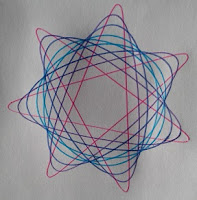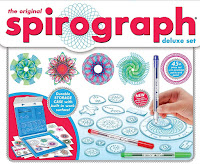A little later we had a discussion about why I considered Spirograph of value when working with kids and math. I explained how patterns are very mathematical. It was a hard sell. But today my (adult) daughter and I were playing with it. We also spent some time figuring out the math behind the patterns.
The number of teeth on each ring and each wheel are listed. The ratio of those numbers determines the pattern. How many points will the star have? Will it look like a star or will it have loops at each point?
 The greatest common factor (GCF) and the lowest common multiple (LCM) between the teeth on the ring and the wheel were needed to figure out how many points there would be.
The greatest common factor (GCF) and the lowest common multiple (LCM) between the teeth on the ring and the wheel were needed to figure out how many points there would be.The drawing to the left has 7-pointed stars. The ring we used to draw this had 105 teeth and the wheel had 45 teeth. (Each colour star was made from a different hole in the same wheel.)
 45 = 15 x 3;
45 = 15 x 3; 105 = 15 x 7.
The GCF is 15.
The LCM is 15 x 3 x 7.
As the 45-tooth wheel travels along the 105-tooth ring, every 45 teeth along the ring, it has completed one rotation. The ticks on the circle to the left mark every 15 teeth. The number 1 is 45 teeth after 0. That marks the first rotation of the wheel. The number 2, 45 teeth later, marks the end of the second rotation. And so on, until we get to the end of the 7th rotation, which matches with 0 again.
The triangle shaped drawing is from a wheel that had exactly one-third the number of teeth that the ring has.
If you can get hold of Spirograph, try it out, experiment! See if you can figure out why it makes the pattern it makes! And have fun making Art with Math!




